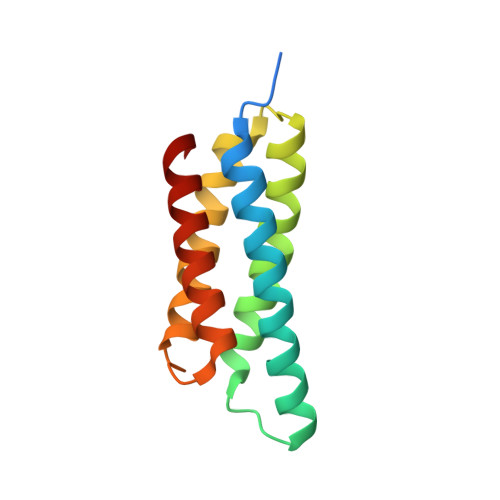A Four-Helix Bundle Stores Copper for Methane Oxidation.
Vita, N., Platsaki, S., Basle, A., Allen, S.J., Paterson, N.G., Waldron, K.J., Dennison, C.(2015) Nature 525: 140
- PubMed: 26308900
- DOI: https://doi.org/10.1038/nature14854
- Primary Citation of Related Structures:
5FJD, 5FJE - PubMed Abstract:
Methane-oxidizing bacteria (methanotrophs) require large quantities of copper for the membrane-bound (particulate) methane monooxygenase. Certain methanotrophs are also able to switch to using the iron-containing soluble methane monooxygenase to catalyse methane oxidation, with this switchover regulated by copper. Methane monooxygenases are nature's primary biological mechanism for suppressing atmospheric levels of methane, a potent greenhouse gas. Furthermore, methanotrophs and methane monooxygenases have enormous potential in bioremediation and for biotransformations producing bulk and fine chemicals, and in bioenergy, particularly considering increased methane availability from renewable sources and hydraulic fracturing of shale rock. Here we discover and characterize a novel copper storage protein (Csp1) from the methanotroph Methylosinus trichosporium OB3b that is exported from the cytosol, and stores copper for particulate methane monooxygenase. Csp1 is a tetramer of four-helix bundles with each monomer binding up to 13 Cu(I) ions in a previously unseen manner via mainly Cys residues that point into the core of the bundle. Csp1 is the first example of a protein that stores a metal within an established protein-folding motif. This work provides a detailed insight into how methanotrophs accumulate copper for the oxidation of methane. Understanding this process is essential if the wide-ranging biotechnological applications of methanotrophs are to be realized. Cytosolic homologues of Csp1 are present in diverse bacteria, thus challenging the dogma that such organisms do not use copper in this location.
Organizational Affiliation:
Institute for Cell and Molecular Biosciences, Medical School, Newcastle University, Newcastle upon Tyne NE2 4HH, UK.














